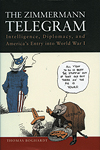
The Zimmermann Telegram: Intelligence, Diplomacy and America’s Entry Into World War I, by Thomas Boghardt, Naval Institute Press, Annapolis, Md., 2012, $36.95
Historians often cite Germany’s resumption of unrestricted submarine warfare in February 1917 as the event that pushed the United States to the brink of intervention in World War I. The Zimmermann Telegram, on the other hand, appears to have driven America over the brink into full belligerency.
German Foreign Secretary Arthur Zimmermann sent the telegram on January 16 to Berlin’s ambassador in Mexico City via the German embassy in Washington, D.C.—well before the public declaration on submarine warfare. Zimmermann proposed that Mexico attack the United States if war between America and Germany looked inevitable. In return, Mexico would receive carte blanche to reconquer Texas, New Mexico and Arizona. Intercepted by British intelligence and published in American newspapers on March 1, the telegram outraged the public and forced the Woodrow Wilson administration to declare war—or so the story goes.
Boghardt’s book is the first detailed study of the telegram to appear in more than 50 years. A senior historian at the U.S. Army Center of Military History and an expert on the history of intelligence and cryptanalysis, Boghardt has marshaled an impressive array of German, British and American sources to support his arguments about the origins, interception and consequences of the telegram.
The telegram originated from earlier approaches to the German government by shady Mexican adventurers; the obsession of some German diplomats with detaching Japan from the Entente; and military demands of Paul von Hindenburg and Erich Ludendorff. It was not, in other words, a considered instrument of German foreign policy but an almost off-the-cuff attempt to distract the United States from Europe. In some of his most interesting passages Boghardt describes how British cryptanalysts intercepted the telegram in the course of routine spying on American diplomatic correspondence, in which the Germans had cunningly embedded their message. Boghardt rejects the standard argument that the telegram pushed the United States into World War I. The American public, he says, quickly lost interest in the telegram, and it failed to impress either interventionists or noninterventionists. It did, however, infuriate Wilson and help overcome his isolationism. Whatever its role in American intervention, the Zimmermann telegram receives thorough treatment in this fascinating book.
—Edward G. Lengel




